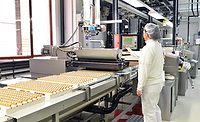Meat packaging has undergone a significant evolution over the years, driven by various factors including labor and productivity concerns, environmental considerations and changing consumer preferences. Now, one of the biggest influences in meat packaging is increasing interest from both consumers and companies in sustainability factors, and particularly in recyclability.
But sustainability is about much more than recycling. It’s about creating a circular system where resources are continuously cycled and reused rather than discarded as waste. And it’s about creating sustainable solutions that are less carbon intensive, meaning they result in lower emissions of carbon dioxide (CO2) and other greenhouse gases into the atmosphere. It’s about setting ambitious environmental impact goals, ones that address the top concerns of companies and consumers alike: pollution and climate change.
So how does packaging play a role in minimizing these environmental concerns?
On the pollution side it’s about maximizing circularity and the two components that make up circularity: beginning of life, using recycled content and items that are more naturally sourced; and end of life, using materials that can be easily recycled. Something that is more circular is less likely to end up in our environment and more likely to be used again in some capacity.
On the climate change side the objective is to minimize your carbon footprint. Shelf life extension, reduction of food waste, transportation efficiency and using high performance-to-weight ratio products like vacuum films or shrink bags all play into this.
The challenge is finding the right balance between packaging solutions that are recyclable and those that preserve product and extend shelf life. This is because emissions associated with food waste are even more damaging to the environment than the packaging itself.
And it’s about improving or maintaining other aspects such as aesthetics, performance, and features needed for new channels, such as leak proof packaging for e-commerce.
The key is finding the right balance between all these concerns so companies can minimize their environmental impact, a goal shared by 83% of Fortune 500 companies according to recent McKinsey research.
The Evolution of Meat Packaging
Over the last 20 years, we’ve seen a tremendous amount of change in meat packaging. When SEE started its CRYOVAC National Meat Case Study in 2002, 51% of product was being cut and packaged at the store level. Now, only 17% is being cut and packaged in-store as it’s become more efficient to move these roles to central cutting facilities.
Today, 83% of everything you see in store is processed and packaged away from the store, and that number has steadily risen year over year. As the share of case-ready packages continues to climb, we’re able to address sustainability concerns with packaging material innovations that improve product protection and reduce waste, including more rigid trays, less foam and less in store overwrap with foam.
In addition, case-ready solutions offer a wide range of distribution and storage flexibility enhancements for both brick-and-mortar retail and e-commerce to help extend shelf life and ultimately to reduce food waste.
 Image by mrsiraphol on Freepik
Image by mrsiraphol on Freepik Current Trends in Sustainable Meat Packaging
Some of the earliest drivers for the adoption of case-ready packaging were requirements for food safety, reducing waste by extending shelf life and the lack of skilled labor in grocery stores. Now, sustainability factors are driving the direction of meat packaging, including:
- Reducing the amount of packaging: The elimination of polystyrene foam trays is one of the big trends for the reduction of materials.
- More recyclable packaging: Eliminating foam trays and going to PET trays is one way brands can make it easier to incorporate recyclable materials. If recycling is not possible due to food contact, then compostable or biodegradable materials are being used to minimize environmental impact.
- Biobased materials: When recycled content is hard to incorporate due to food safety regulations, then biobased materials are a good option. Biobased food packaging is derived from renewable resources such as plant-based materials. Since they can be replenished through agricultural practices, they can improve the sustainable characteristics of the packaging.
- Balancing shelf life with packaging that provides necessary product visibility: Packaging materials need to keep food fresher longer as the products travel through the distribution system. At the same time, packaging needs to deliver on the aesthetics that will attract consumers as well as the features that consumers desire…packaging that is leak proof and easy to open.
- Smaller meat cutting facilities that are closer to population centers: A case-ready package only has so much shelf life so it is best to cut and pack in a location close to the customer so valuable shelf life isn't used in long distance distribution. These centralized facilities, whether retailer or supplier owned, also have the ability to produce greater yields and less waste than general processing facilities.
- More vacuum packaging: Rather than shipping air, vacuum packaging allows you to ship more weight and more product per cube space, so you maximize shipping efficiencies. Vacuum packaging also helps extend shelf life and reduce food waste. By removing oxygen and creating a vacuum-sealed environment, vacuum packaging reduces the oxidation process that can cause food to spoil or lose its flavor, color and nutritional value.
Finding the Right Balance
Let’s take a closer look at why balance is so important. An extreme example is to get rid of plastic and go to all paper. But paper is a porous material, allowing air and moisture to pass through it easily, which means it doesn’t provide an effective barrier against contaminants. This causes safety concerns and significantly reduces the shelf life of meat products.
Clearly, you’re not going to get the shelf life you need to ship meats across your region if you’re using an all paper package. Instead, you’ll need to balance those tradeoffs and maintain the performance attributes that are necessary—shelf life and food waste reduction—while still incorporating the product aesthetics to appeal to consumers at the shelf.
While using some plastic packaging is essential for food quality performance, we can be good stewards of the plastic we are using by choosing materials that increase the chances of effective recycling. Still, this can be a challenge because the presence of food residues in food packaging materials can contaminate the recycling stream and sorting and separating techniques are still being perfected. So how do we make meat packaging sustainable when the opportunities to recycle materials that come in contact with food are limited?
First, there is an opportunity to recycle rinsed rigid trays. While we are not currently able to recycle at the rate we would like, this process is increasing in adoption.
Next, while we currently don’t have a nationwide scheme for efficiently reclaiming and reusing these materials or recycling them at curbside, education programs can help consumers understand how to properly separate and dispose of food packaging materials to encourage responsible disposal practices.
And then there is the challenge of logistics, specifically transportation costs for implementing a curbside recycling program for food packaging materials. What makes plastic packaging so efficient in the first place is how little of it is needed to provide necessary protection. For that very reason, collecting and transporting such lightweight materials from a number of collection points is economically challenging, since a large volume is required to reach the optimal load for transportation efficiency. In this case, the number of collection points in a curbside scheme make it challenging to achieve economies of scale in the recycling process.
A complete solution for consumer-level recyclability may still be elusive, but we can explore ways to gather more material at a single location, which would simplify and reduce the cost of collection. This is what makes B2B/industrial applications an interesting place to focus on, and there already are some test programs in place where retailers can return materials which then go through an advanced recycling process. With larger accumulations of materials in one spot, industrial facilities can process a higher volume of lightweight materials, making it more cost-effective compared to fragmented B2C or consumer recycling programs.
Working with plants that have a lot of plastic waste, we can collect bags and feed those back into a recycling stream. We can create a revenue stream for recycled materials and make it financially attractive to build a market for these materials.
 There's a lot to consider when it comes to sustainable packaging. Image courtesy of SEE
There's a lot to consider when it comes to sustainable packaging. Image courtesy of SEEThe Golden Ticket to Sustainability, or is There One?
So what’s the best solution? Plastic, paper, plant-based materials? What about foams or fiber-based solutions?
The point is, sustainability is a complex conversation, there is no single answer and there’s no golden ticket to sustainability.
For example, paper-based materials may be considered sustainable, but the production of paper is very water intensive, not to mention it takes a long time to grow the trees needed. Paper or fiber-based materials are nearly always going to be more carbon intensive, and while it may seem that paper-based materials have more recycling or composting options available, that’s not the case when it is being used to wrap raw meat. It’s complicated to rinse paper packaging, even more so than plastic, and that means that food contamination issues will hinder recyclability.
On the other hand, plastic or synthetic based solutions are more efficient and higher performing, and thus have a smaller carbon impact but struggle with circularity.
You need to consider both the carbon impact and the circularity attributes in order to make a sound decision. And when you look at the broader picture outside of sustainability, including price, aesthetics and food regulations, there are even more considerations.
Now, many regions are starting to implement legislation to promote sustainable packaging practices and reduce environmental impact. In the U.S., 44 states have either current laws or pending legislation that address some attribute of material and its recycled content. And other bills have recently been introduced with the intent of improving our nation’s recycling and composting systems. As of July 2023, 97 bills related to plastic packaging have been introduced in state legislatures with the aim of reducing waste, including by increasing recycling and educating consumers. One thing business leaders can do is to be proactive and get ahead of legislation on sustainable practices by assessing our own energy consumption, waste management, and supply chain practices, and setting ambitious sustainability goals.
Ultimately, the solution is looking for the right balance. We’d like to make plastic solutions more circular and make fiber solutions higher performing and more carbon efficient. Let’s come at it from both angles, and as an industry, continue to innovate and collaborate to find effective packaging solutions that balance food safety, shelf life and environmental considerations.




